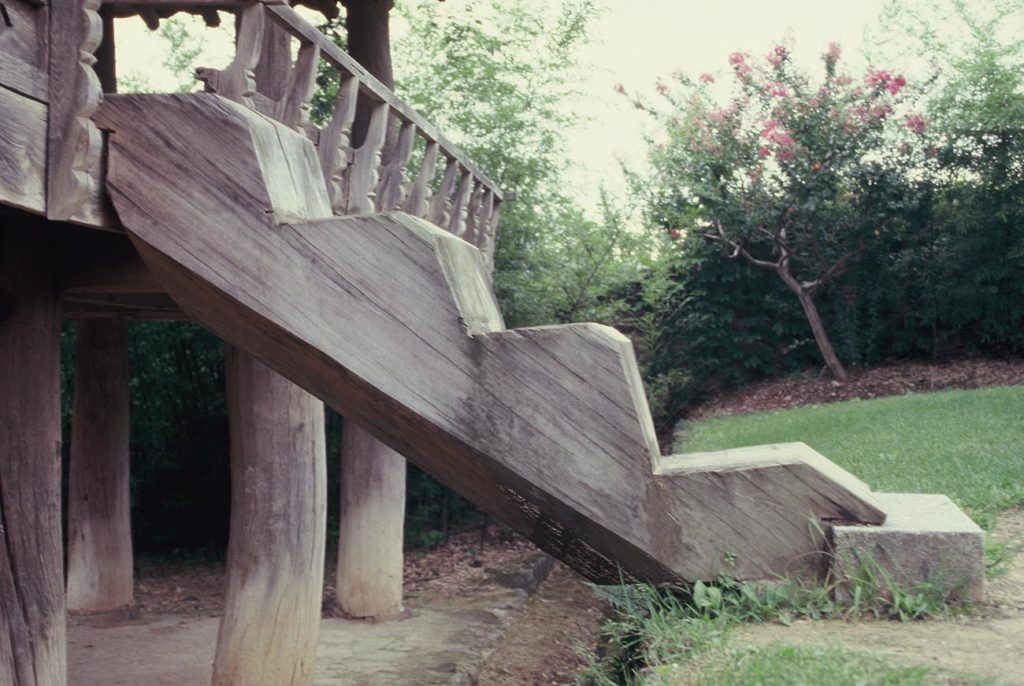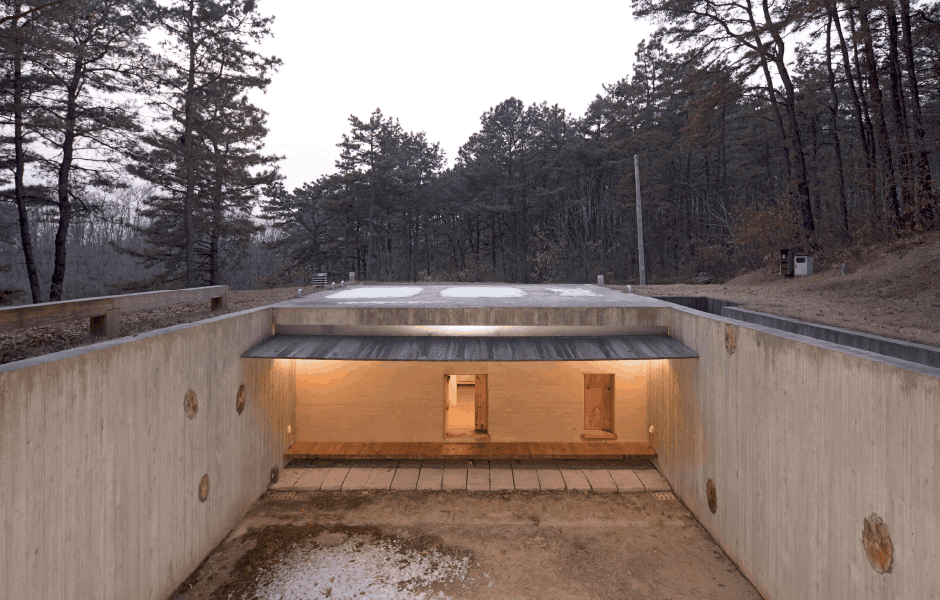The Land's Architecture
땅의 건축
Text by Byoungsoo cho 조병수
Translation by Mimi Park 박상미
Good architecture highlights the inherent beauty of its natural surroundings, and, mare importantly, it allows for a more harmonious state of coexisting between humans and the natural world it occupies. It helps us to perceive our environment more intentionally and to experience the earth more actively and more viscerally.
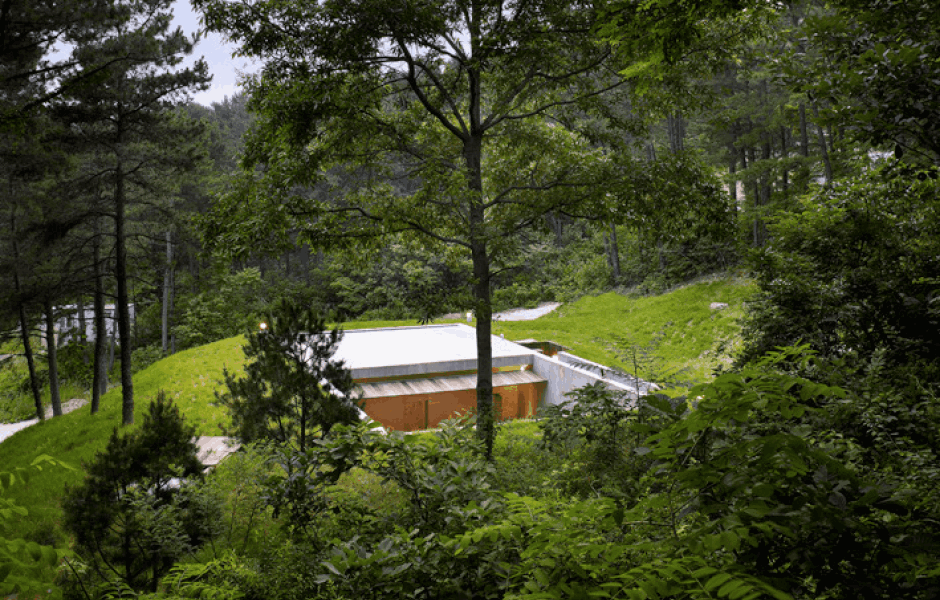
Therefore, good architecture ultimately amounts to more than just balancing the design.with the immediately visible characteristics of a piece of land. Through a dedicated study to notice nuances like the flow of water on a given site, or the flow of wind, or the playful flow of line along the back of a rollicking ridge, and other such wonderful natural elements, novel interpretations of a site can be created to allow for richer experiences.
Thus the ideology behind the excellent architecture is one that holds on highest regard the question of how to honor the existing nature, and allow the ground and the people to exist in dialogue with one another. It does not preoccupy itself with how to design a building that looks impressive.
This ideology necessitates an in-depth consideration of not only the evident physical functions of a piece of land but also the inherent ecological and even emotive temperaments of the site. Architecture has the potential to transcend the state of being mere artificial constructs thrust over a piece of land and can emerge instead as a discourse in itself, through which the inherent value and dignity of that land can shine.
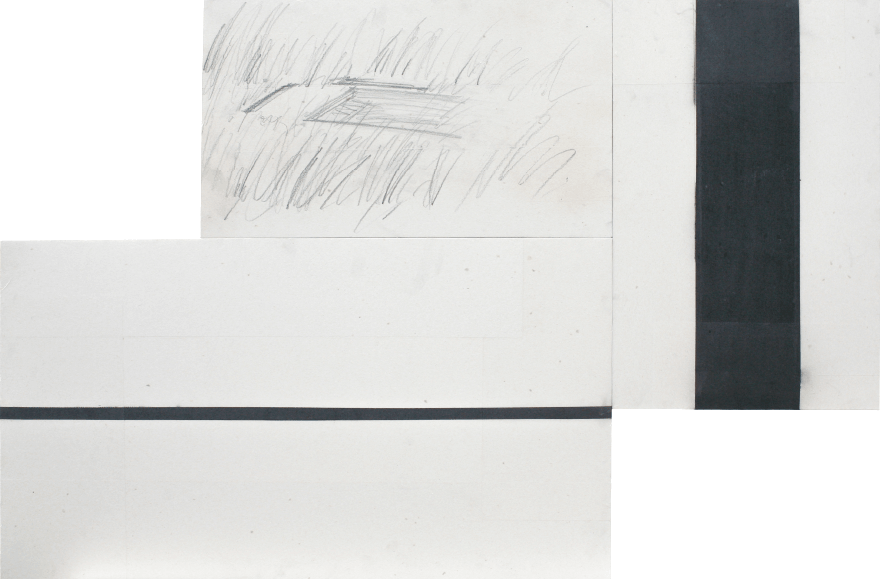
Through this process of recognizing architecture as a manifestation of nature, and humanity, it is possible to dismantle that rarefied notion that great architecture is necessarily composed of grandiose buildings that have nothing to do with everyday life. Instead, we can acknowledge that truly great architecture can be, perhaps must be, approachable and comfortable both in our lives and the nature in which it exists.
Architecture for the land, or Architecture of Land, is sustainable. It is a modus operandi that, rather than bend the ground to its will, seeks to be fluent in the ways of the land; flowing and breaking with it, leaning into it, truly joining the earth. Moreover, the depth to which we genuinely know a piece of land dictates how much love and respect we can show for it in our work as architects. Through this process, it will be possible to make architecture that emerges from the site itself. Unlike the great temples of ancient Greece, or the pyramids, or even Andrea Palladio's (1508-1580), Villa la Rotonda (1571), Architecture of Land more often expresses itself not in symmetrical, predictable shapes designed around a central space, but tends to embrace the curves of the Landscape. This kind of architecture tends to flow with the whole expression of the site, leaning against a hill, or riding the contours of the waterways, as if flowing in and out of the very state of existing independently of the ground, rather than perch atop the highest point of a piece of land. At its best, it allows not just the wind and the light, but also time and space, to flow through its whole being. The Architecture of Land departs from the land and also arrives back to it.

The Architecture of Land must be concise. The land is always concise, and architecture cannot hope to become a part of the land if it is pompous, or obtrusive. Humility must oe evident in the composition of the spaces, in the construction materials, and even sometimes, the methods of the construction themselves.

First, how can we make composition of the interior spaces concise, just so? We must start from the purest, most possible straightforward expression of the design, and from the adjust, not according to our preconceived notions of the spaces we want, but to the natural conditions of the ground we are building on. We have to use our creative faculties to imagine the space that could honor the form of the land we are on and also serve our needs. True luxury in architecture comes from the amicable relationship a building has with the land it exists on - therefore, there is always room for simplicity.
Second, when it comes to the materials that comprise the spaces we are making, less is more. It is preferable to use three types of materials rather than four, or even two rat~er than three. We must use a moderation that matches the natural conditions of the site. The materials can vary in roughness and refinement, according, again, to the land. Through this restraint, we achieve a richness that resonates with a depth that is impossible to find through thoughtless noisiness in the materials.
Third, the framework of the structure can be buried within the land, leaned up against it, or engage in other. ways of having a conversation with the ground. More so than in conventional architecture, it is essential to find novel solutions that confront the challenges of individual sites. In these solutions, architects must strive to be rational, organic, and creative, as nature's solutions are.

Thus, Architecture of Land, through aptness of design, materials, and structural considerations, becomes sustainable and bound up together with the earth. The land is sustainable; therefore, the Architecture of Land must, above all, be sustainable, ecological and otherwise.
The Architecture of Land not only showcases natural phenomena like the shifting sky and ensuing variations in the light; the turning over of seasons; or the rhythm of slopes, the wind, even flora and fauna. It can celebrate such phenomena by using the knowledge of these patterns and forces to situate its various parts to make use of them. For example, architecture partially buried in the ground can benefit from the existing geothermal dynamics to maintain warmth in the winter, and coolness in the summer. The pattern of wind across a particular parcel of land may follow the contours of the site, sending cooling forest air down along it. If there happens to be water along the way, the air will be even cooler. In the winter the wind may tend to brush up against the ridgeline, becoming milder in temperature and softer overall. When it is possible to find ways to influence temperature, ventilation and light in the spaces that are built, nature will be treated with respect. In such ways, the work can itself brea he and become living, just like the ecology inherent in mountains, in forests, and in the ground itself. Design that takes such factors into account can spring forth as if creating itself, revealing its solutions to the architect during work.
When a house embraces the contours of the ground, even if small, the spaces that open up within can be well-organized so that it can hold much life, perhaps even more comfortably than in larger spaces. The Architecture of Land can create small spaces that feel much larger. When small interior spaces pair with adequate exterior spaces and the two situations are in balanced relation to one another, it is possible to create a home that is a sort of ecosystem, where many different microclimates can be found within different areas. When architecture is bound up with the land, we can live lives in a way to experience space, and the surrounding ear.th and ecology, more personally and thoroughly.
The Architecture of Land is an at form rooted in the wisdom inherent in the land itself - it turns from the blind pursuit of rigid convention and preconceived notions of what buildings ought to be, and seeks, first and foremost, not to harm. lt is a matter of following the paths of light and wind and water, to build smaller so that we can live larger. It is architecture not of faraway ideals and ostentation, but one that is instead grounded in being precise, concise, modest. It can be an architecture of great humility, of less - not contrived minimalism, but more a wholesome emptiness, of space, of process, that leaves room to be filled with life, experiences, and understanding, tittle by little. It harbors an emptiness that is akin to the emptiness and modesty inherent in nature so that complements and is complemented by the natural environment that it inhabits. It is an architecture that seeks sustainability in every way. It is an architecture that knows that it cannot stand on its own without the stories of the land, the nature, the people, and it tells these stories, implicitly, in through its very presence.
좋은 건축은 자연의 고유한 아름다움을 강조하며, 더 중요하게는 인간과 자연의 조화로운 공존을 돕는다. 우리의 환경을 더 의도적으로 인식하게 하며 지구를 더 능동적이고 본능적으로 경험하도록 돕는다.

좋은 건축은 단순히 겉으로 보여지는 땅의 특성과 디자인적 균형을 맞추어가는 것 이상의 작업을 필요로 한다. 물과 바람의 흐름, 구르는 능선의 장난기 넘치는 선형, 그리고 이외에도 여러가지 놀라운 자연적 요소들과 뉘앙스를 알아차리기 위한 헌신적인 연구를 통해 건축가는 사이트에 대한 독창적인 해석을 가지게 된다. 그리고 이를 통해 우리는 궁극적으로 자연을 더 풍부하게 경험하게 되는 것이다.
따라서 훌륭한 건축적 이념은 기존 땅을 최대한 존중하는 방법과, 땅과 인간의 유기적인 관계를 이끌어내는 사안을 가장 중요시한다. 인상적인 건물의 외관을 만드는 행위에 집착하지 않는다.
이러한 이념은 주어진 땅의 명백한 물리적 특성뿐만 아니라 그 땅의 고유한 생태적, 감정적 기질에 대한 심층적인 고려를 필요로 한다. 여기서 건축은 더 이상 단순히 땅 위에 얹혀진 인공적인 구조물에 머물지 않는다. 건축은 주어진 땅의 고유한 가치와 존엄성이 드러나도록 하는 잠재력을 지니게 되며 그 자체로서의 담론을 만들어낸다. 건축을 자연과 인류의 구현으로 인식한다면, 위대한 건축은 일상 생활과 무관한 웅장한 건물로 구성되어 있다는 통상적인 관념을 뛰어넘을 수 있다. 진정 위대한 건축은 우리의 삶과 그 건축물이 존재하는 자연 속에서 접근 가능하고 편안한 존재로 경험되어야 한다.

땅을 위한 건축, 즉 땅의 건축은 지속가능하다. 그것은 땅을 인간의 의도에 맞게 구부리기보다는 땅과 함께 흐르고 부서지고 기대고, 진정으로 지구에 합류하는 방식이다. 건축가로서 어떤 땅을 진정성 있게 이해하는 깊이는 자연을 사랑하며 존중하는 건축을 만들어 낼 수 있는 능력과 직결된다. 이 과정을 통해 우리는 땅으로부터 나는 건축을 만들 수 있다. 고대 그리스의 위대한 사원이나 피라미드, 심지어 안드레아 팔라디오의 1508-1580) 빌라 라 로톤다(1571년)와는 달리, 땅의 건축은 중앙 공간을 중심으로 설계된 대칭적이고 예측 가능한 모양으로 표현되지 않는 경우가 더 많다. 오히려 풍경의 곡선을 포용하며, 땅의 가장 높은 지점 위에 얹히기보다는 부지의 전체적인 지형과 함께 흐르거나, 언덕에 기대거나, 수로의 윤곽을 타는 경향이 있다. 바람과 빛 뿐만 아니라 시간과 공간도 그 존재 전체를 흐르게 한다. 땅의 건축은 땅에서 출발하여 땅으로 다시 돌아간다.

땅은 항상 간결하기에 만일 건축이 그 스스로가 현란하고자 한다면 결코 땅의 일부가 될 수 없을 것이다. 공간의 구성, 재료, 그리고 때로는 시공의 방식에 이르기까지 건축에는 겸손이 묻어나야 한다.
첫째, 실내공간의 구성을 간결하게 하는 방법은 무엇인가? 우리는 가장 순수하고 직접적인 표현에서 출발해야 하며, 건축가의 선입견이 아닌 땅의 선천적인 조건에 의해 공간을 발전시켜야 한다. 우리가 살고 있는 땅의 형태를 가장 존중하고 또한 우리의 필요를 공급하는 공간을 상상하는 데에 우리의 창조적 능력을 집중해야 한다. 건축에서 진정한 사치는 건물과 땅의 우호적인 관계에서 비롯된다. 따라서, 땅의 건축에는 늘 단순함을 위한 여지가 있다.
둘째, 공간을 구성하는 재료는 적을수록 좋다. 네개의 각기 다른 재료보다는 단연 세가지가 낫고, 어쩌면 세가지보다 두가지가 더 좋을 수 있다. 우리는 주어진 자연 조건에 맞게 절제해야 한다. 재료의 거칠기와 정교함의 정도 또한 사이트의 조건에 따라야 한다. 이러한 제약들을 통해 우리는 재료의 무분별한 소음들을 제거하고 비로소 어떠한 깊이에 이를 수 있을 것이다.
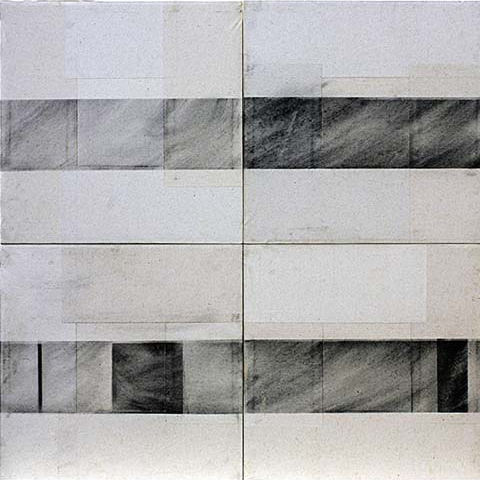
셋째, 구조물의 틀은 땅안에 묻히거나, 기대거나, 혹은 다른 여러가지 방법으로 땅과의 관계를 만들어 내도록 해야한다. 우리는 지금까지 행해진 건축보다 더더욱 각 사이트에 내재되어 있는 도전들에 새롭게 직면해야 하며 독창적인 솔루션을 찾아내야 한다. 자연의 해결책들이 그러하듯 우리 역시 합리적이고 유기적이며 창의적인 답안들을 제시하기 위해 끝없는 노력을 기울여야 한다.
따라서 땅의 건축은 적합한 디자인, 재료, 그리고 구조를 통해 지속가능해지고 지구와 결부된다. 땅은 지속가능하다. 그러므로, 땅의 건축 또한, 무엇보다도 지속가능하고, 생태적이어야 한다.
땅의 건축은 다양한 자연현상들 - 즉, 하늘과 빛의 변화, 계절의 전환 또는 경사, 바람, 그리고 동식물의 리듬까지도 보여주고 담아낼수 있다. 보여주는것에 그치지 않고 자연의 질서에 대한 지식을 활용함으로써 또 자연을 기념할 수 있다. 예를 들어, 부분적으로 땅에 묻힌 건축은 지열을 사용하여 겨울에는 따뜻함을, 여름에는 시원함을 유지할 수 있다. 특정 땅을 가로 지르는 바람의 패턴은 그 땅의 윤곽을 따라 차가운 숲 공기를 흘려 보내기도 한다. 이 공기는 물을 만나면 더욱 시원해지고 겨울에는 산등성이에 부딪혀 온도가 온화해지고 전체적으로 부드러워진다. 우리는 건축의 공간에서도 온도, 환기, 빛을 조절하는 자연의 방법들을 찾아냄으로써 주위 환경을 존중할 수 있다. 이러한 건축은 산, 숲, 그리고 땅에 내재된 생태와 마찬가지로 그 자체가 숨을 쉬고 살 수 있다. 이러한 요소들을 고려한 디자인은 마치 자신을 창조하는 것처럼 생겨나며, 작업 중에 건축가에게 그 스스로 해결책을 드러낼 수 있다.
집이 땅의 윤곽을 포용할 때, 비록 작더라도 그 안에 펼쳐지는 공간은 잘 조직되어 더 많은 삶을 담아낼 수 있으며, 이는 단순히 크기만 한 집보다 오히려 안정적일 것이라 생각한다. 땅의 건축은 더 큰 느낌을 주는 여러 작은 공간들을 만들 수 있다. 작은 실내공간이 적절한 외부공간을 만날때, 그리고 서로가 균형을 이룰때, 마치 다양한 미세기후로 구성된 하나의 살아있는 생태계와 같은 집을 만들 수 있을 것이다. 건축이 땅과 결부되어 있을 때 우리는 땅과 하나된 삶을 살아내고, 주변 지구와 생태를 보다 개인적이고 심도있게 경험하게 된다.
땅의 건축은 땅에 내재된 지혜에 뿌리를 둔 예술 형식이다. 그것은 '건축이 어떠해야 하는가'에 대한 엄격한 관습과 선입견을 맹목적으로 따르지 않으며, 무엇보다도 해를 끼치지 않을 것을 추구한다. 빛, 바람, 그리고 물의 길을 따르고자 하며, 우리가 더 크게 살 수 있도록 더 작게 짓는다. 먼 이상과 과시가 아닌 정확하고 간결하고 겸손한 것에 기반을 둔 건축이다. 이는 굉장히 겸손한 건축일 수 있다. 즉, 꾸며낸 미니멀리즘이 아니라, 삶, 과정, 그리고 경험으로 채워질 여지를 남겨둔, 어쩌면 더욱 온전한 비움, 공간, 그리고 과정에 관한 것이다. 땅의 건축은 자연속에 있는 비움과 겸손과 흡사한 비움을 품고 있어 주위의 자연환경에 의해 보완되고 또 자연을 보완한다. 이는 모든 면에서 지속가능성을 추구하는 건축물이다. 땅과 자연, 그리고 사람의 이야기 없이는 스스로 설 수 없다는 것을 알고 있는 건축물이며, 그 존재 자체로써 암묵적으로 이러한 이야기들을 들려준다.
RELATED POSTS

